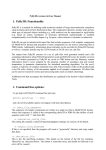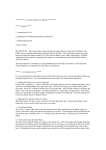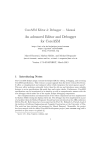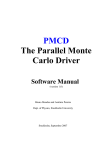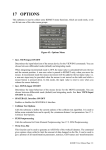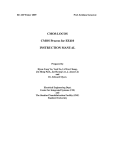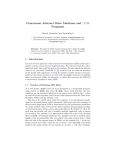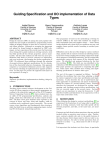Download Abstraction using ASM Tools
Transcript
Abstraction using ASM Tools Olav Jensen, Raymond Koteng, Kjetil Monge, and Andreas Prinz Faculty of Engineering, Agder University College Grooseveien 36, N-4876 Grimstad, Norway [email protected] Abstract. Abstract State Machines (ASM) are proven to be able to represent any algorithm at the right level of abstraction. This result speaks about the running algorithm, i.e. in which way the ASM does the same steps as the algorithm. However, in practice it is also important to speak about the description of the algorithm. The purpose of this paper is to compare the levels of abstraction between ASM and other description technologies. In order to do this, we formulated a clustering algorithm in two ASM dialects (CoreASM and AsmL) as well as in ‘mathematics’ and in Java. We compare the abstraction level of these descriptions and the strengths and weaknesses of the different languages. The results show that there is a rather big difference between these languages regarding syntax, abstraction level, and runtime. 1 Introduction This paper is a report about an experiment done to check the possibilities of abstraction in Abstract State Machines (ASM) [1]. In the experiment, we describe a clustering algorithm using ‘mathematics’, two ASM dialects and Java. We compare the implementations of the algorithms according to the ease of use, ease of description of abstraction and runtime. Here we will first give a short introduction to ASM and to clustering. 1.1 Abstract State Machines Abstract State Machines (ASM) are a formal way to describe algorithms [5]. They are proven to be able to describe any algorithm, and they are even able to describe them at the right level of abstraction [9]. Abstract State Machines (formerly called evolving algebras) were introduced by Yuri Gurevich, based on the mathematical concept of algebra and an assignment as the basic way to change between states. ASM have a number of interesting properties (partly taken from Wikipedia). Precision Since ASM are based on mathematics, it is clear they provide a precise way of describing algorithms. Please note that ASM do not come with a predefined (standard) syntax, but the precision is given in terms of the underlying semantics. ASMs use classical mathematical structures to describe states of a computation, and differences between structures to describe state changes. 2 Faithfulness Given a specification, how does one know that the specification accurately describes the corresponding real system? Since there is no method in principle to translate from the concrete world into an abstract specification, one needs to be able to see the correspondence between specification and reality directly, by inspection. ASMs allow for the use of the terms and concepts of the problem domain immediately, with a minimum of notational coding. Many popular specification methods require a fair amount of notational coding which makes this task more difficult. Understandability How easy is it to read and write specifications using a particular methodology? If the system is difficult to read and write, few people will use it. ASM programs use an extremely simple syntax, which can be read even by novices as a form of pseudo-code. Other specification methods, notably denotational semantics, use complicated syntax whose semantics are more difficult to read and write. Executability Another way to determine the correctness of a specification is to execute the specification directly. A specification methodology which is executable allows one to test for errors in the specification. Additionally, testing can help one to verify the correctness of a system by experimenting with various safety or liveness properties. Scalability It is often useful to be able to describe a system at several different layers of abstraction. With multiple layers, one can examine particular features of a system while easily ignoring others. Proving properties about systems also can be made easier, as the highest abstraction level is often easily proved correct and each lower abstraction level need only be proven correct with respect to the previous level. Generality We seek a methodology which is useful in a wide variety of domains: sequential, parallel, and distributed systems; abstract-time and real-time systems; finite-state and infinite-state domains. Many methodologies (e.g. finite model checking, timed input-output automata, various temporal logics) have shown their usefulness in particular domains; ASMs have been shown to be useful in all of these domains. There exist several tools that implement the ASM methodology. We have chosen to make our experiments with the CoreASM and the AsmL environments. CoreASM The CoreASM project [3] is an open source project which is developed by Ph. D. students at the School of Computing Science, Simon Fraser University, Canada. The goal is to make a formal language which focuses on the design of an executable abstract state machine, or ASM. CoreASM has support for high-level design, experimental validation and formal verification of abstract system models. CoreASM has a plug-in for the Eclipse framework. AsmL AsmL, or Abstract State Machine Language [7], is a formal language developed by Microsoft. AsmL is an executable specification language based on the theory of Abstract State Machines. AsmL is used in situations where precise, non-ambiguous meaning is important. 3 1.2 Clustering Data clustering [4] is a common technique for statistical data analysis, which is used in many fields, including unsupervised machine learning, data mining, pattern recognition, image analysis and bioinformatics. The main idea with clustering is to classify the objects in question into groups, such that a partitioning of the data set is reached. Thus clustering is a technique for classification of objects. A simpler way of saying this is that one should put objects which share traits or similarities into the same cluster, while objects with different traits should be put into different clusters. One example of this trait could be Euclidean distance between objects. In our reference book Pattern classification [4], several algorithms for clustering are given and the properties of all of them are described. We have picked out a relatively simple algorithm for purposes of the example. The algorithm we have picked out starts with the idea that initially all objects are associated with arbitrary clusters. The algorithm itself just picks out an arbitrary element, and tries to place it into another cluster. If this improves the overall clustering distance, the change is performed. The algorithm runs until there are no changes over a long period. See chapter 2 for a more detailed description of the algorithm. For our purpose it is not necessary to go into details of quality of clustering algorithms, because we just want to compare description properties of the languages. 1.3 Delimitations and assumptions There are several possibilities for criteria for clustering, but we will just use for our example two-dimensional points that are grouped according to geometrical (Euclidian) distance. One simplifying property of Euclidean distance is that distances in Euclidean space are symmetric, i.e. the distance from A to B is equal to the distance from B to A. In order to have a controlled environment to test and compare the algorithms on different platforms, we have used artificial data consisting of points in two dimensions, (x,y). By artificial we mean a problem generated without a specific purpose in mind instead of an existing problem. 1.4 Structure of the Paper This paper is structured as follows. In section 2, we repeat the definition of the clustering algorithm given in [4] together with some discussion. Afterwards, we present an AsmL specification in Section 3 and a CoreASM specification in Section 4 as well as a Java implementation in Section 5. We present and discuss our finding in section 6 and present our conclusions in section 7. 2 Description of the Clustering Algorithm The clustering algorithms we have used in our experiments are described in the book Pattern classification [4] pages 549 and 550 as follows. 4 The approach most frequently used in seeking optimal partitions is iterative optimization. The basic idea is to find some reasonable initial partition and to “move” samples from one group to another if such a move will improve the value of the criterion function. Like hill-climbing procedures in general, these approaches guarantee local but not global optimization. Different starting points can lead to different solutions, and one never knows whether or not the best solution has been found. Despite these limitations, the fact that the computational requirements are bearable makes this approach attractive. Let us consider the use of iterative improvement to minimize the sum-of-squared-error criterion Je written as: Je = c X Ji , i=1 Where an effective error per cluster is defined to be X Ji = ||x − mi ||2 xDi and the mean of each cluster is, as before, mi = 1 X x. ni xDi Suppose that a sample x̂ currently in cluster Di is tentatively moved to Dj . Then mj changes to m∗j = mj + x̂ − mj nj + 1 and Jj increases to Jj∗ = Jj + nj ||x̂ − mj ||2 . nj + 1 Under the assumption that ni 6= 1(singleton clusters should not be destroyed), mi changes to m∗i = mi − x̂ − m1 ni − 1 and Ji decreases to ∗ J i = Ji − ni ||x̂ − mi ||2 . ni − 1 These equations greatly simplify the computation of the change in the criterion function. The transfer of x̂ from Di to Dj is advantageous if the decrease in Ji is greater than the increase in Jj . This is the case if 5 ni nj ||x̂ − mi ||2 > ||x̂ − mj ||2 , ni − 1 nj + 1 which typical happens whenever x̂ is closer to mj than mi . If reassignment is profitable, the greatest decrease in sum of squared error is obtained by selecting the cluster for which nj ||x̂ − mj ||2 /(nj + 1) is minimum. This leads to the following clustering procedure: Algorithm (Basic Iterative Minimum-Squared-Error Clustering) begin initialize n, c, m1 , m2 ..., mc do randomly select a sample x̂ i ←− arg min ||mi − x̂|| (classif y x̂) if ni 6= 1 then compute ( n j ||x̂ − mj ||2 if j 6= i ρj = njn+1 j 2 if j = i nj −1 ||x̂ − mi || if ρk ≤ ρj for all j then transf er x̂ to Dk recompute Je , mi , mk until no change in Je , in n attempts return m1 , m2 ..., mc end 2.1 Analysis of the Algorithm When looking at the algorithm, it first turns out that the algorithm does describe only the clustering itself. When we think of a complete application, we will have some more work to be done. In fact, a real application is divided into three different sections; setup phase, algorithm and back-end. The description above does only talk about the algorithm. Another comment on the algorithm is that it is not very clear in the description in the text. There it says that one arbitrary point is taken and placed into another cluster. From the more formal algorithm it can be seen, that in fact the point is placed into the best cluster available, i.e. the cluster with a centre that has least distance to this point. The algorithm description does also include a small problem. The first statement is that the cluster for the chosen point has to be found. This cannot be done by calculating the distance, but by looking into the current cluster element sets. We have to take the cluster the point is included in.1 In our analysis, we will look at the different description methods and how they are able to cover the complete and correct algorithm for the clustering. Here we do only want to note that the algorithm description is abstract about the front-end and back-end parts in that it is not mentioned. This would not be enough for a complete description. 1 This is a nice argument for executability - if the algorithm written down had been executable, this error would have been detected. 6 Front-end The front-end phase will be used for initializing the problem by reading a pre-stored problem (set of points) from a file and starting to initialize the problem. The file contains information about the number of clusters, number of points and an initial assignment to the clusters. The setup phase is finished with a visual representation of the problem (see also back-end). Figure 1 shows how the clusters are initialized before the cluster algorithm starts. We have taken the same initial clusters for all three approaches. The initial clusters contain random points, where the points themselves are generated manually. The different colors indicate the different clusters and a line is drawn from the mean of each cluster to their points. Fig. 1. Clustering front-end phase Algorithm The algorithm part of the framework will do the actual clustering. The problem is given by the front-end phase and the algorithm starts to work on the problem. The clustering can be done using CoreASM, AsmL or Java. Back-end The back-end shall present the results of the algorithm. We use different colors to indicate the clusters and the cluster centre to show how the cluster looks. This way it is easy to visually evaluate the results of the cluster algorithm. Figure 2 shows the final result of the clustering. All points are gathered into the four natural clusters that the problem consists of. 3 Implementation in AsmL AsmL model The AsmL framework is made to work together with the .NET framework [6]. Therefore AsmL includes several elements that are not directly related to the original ASM definition. In particular, it is possible to define 7 Fig. 2. Clustering back-end phase classes and methods using AsmL. However, most of the basic ASM functionality is still available. Because we want to stay as close to ASM as possible, in our AsmL description we do not use classes. This also makes it easier to compare the AsmL and CoreASM solutions. The first thing to define in ASM and thus also in AsmL is related to the structure of the problem. As we want to describe state transitions, we have to describe the state first. This means in our case that we have to define cluster and point which are structures. The point structure has two Integer elements x and y containing the x and y location values of the point. The cluster structure has three elements: one set of included points, one center point named centerPoint and a variable for storing the clusters sum-of-squared-error value (SSR). The use of structures proved very helpful for the description, because these are the units of understanding of the algorithm. In standard ASM, a structure relates to an abstract object having an access function for each of the structure fields. But then again, having a structure in a set does not allow to change its fields. This was at times unhandy for our problem. Syntax The AsmL syntax structure is built on indentation. A sequential ASM step is declared by the keyword ‘step’ followed by the (parallel) code for the step. Updates to variables will be performed after the step has been processed. Internally it seems that code is read sequentially, while the updates within a single step are performed simultaneously. So that in the step below, step WriteLine(’’foo’’) WriteLine(’’bar’’) X := Y Y := X 8 foo will always be printed in the console before bar. But the updates to the variables x and y are performed at the same time, effectively setting x to the old value of y and y to the old value of x. This is consistent with the ASM model. One should not need to worry about how the steps are performed in details, only that the more abstract ideas does what it’s supposed to do. Indentation can be a confusing way of defining blocks of code. One seemingly small error might be hard to spot, but could change the way the entire specification performs. The description for calculating the SSR (Ji ) in AsmL is as follows. calculateSSR(c as Cluster) as Double var ssr as Double = 0.0 step foreach p in c.pts ssr := ssr +(((p.x - c.centerPoint.x)*(p.x - c.centerPoint.x))+ ((p.y - c.centerPoint.y)*(p.y -c.centerPoint.y))) step return ssr It should be noted that AsmL introduced a special notation for sequentially running through a collection of objects, which is the ‘foreach’ construct used above. This will lead to a sequence of steps. The description of the impact of adding or loosing one point to a cluster (ρj ) is as follows. let tmp = if (exists p1 in c.pts where p = p1) then -1 else 1 return Size(c.pts)/(Size(c.pts)+tmp)*dist(p,c) Finally, the main algorithm looks like this. clusterStep() choose c1Tmp as Cluster in clusters where Size(c1Tmp.pts) > 1 choose p in c1Tmp.pts choose c2Tmp in clusters where forall cc in clusters holds newSSR(c2Tmp,p) <= newSSR(cc,p) var c1 = c1Tmp var c2 = c2Tmp step if (c1<>c2) let increase = increaseSSR(c2,p) let decrease = decreaseSSR(c1,p) let hlpssr1 = calculateSSR(c1) let hlpssr2 = calculateSSR(c2) if (decrease > increase) step c2.ssr := c2.ssr+increase c1.ssr := c1.ssr-decrease add p to c2.pts remove p from c1.pts c2.centerPoint := updateMeanAdd(c2,p) 9 c1.centerPoint := updateMeanSub(c1,p) totalSSR := (totalSSR + increase - decrease) remove c1Tmp from clusters remove c2Tmp from clusters step add c1 to clusters add c2 to clusters step iTotalRuns := 1 + iTotalRuns if (iRuns = iterationCount) if (oldSSR > totalSSR) oldSSR := totalSSR as Double iRuns := 0 else bFinished := true else iRuns := iRuns + 1 Front-end and Back-end In order to handle front-end and back-end, we could use AsmLs embedding in .NET. This means it is possible to create a library using C#.NET for reading files and displaying the results. In order to have a most unique display of the results, we have chosen to stream all result via the Java interface, such that for AsmL we had to write out the result for later use in Java. Because AsmL is a Microsoft based program we were not able to link this directly to the framework that we have made in Java. However the SpecExplorer program creates an .EXE file from the compiled project which can be started directly from the framework. To be able to present the results in the same framework we have created an XML generator from the .NET library. This XML generator is included in the AsmL project and creates an XML file from the clustering results, which we can open manually from our main framework. This way we can give a visual representing from the experiments in our framework when the actual clustering is done. 4 Implementation in CoreASM CoreASM model CoreASM is supposed to be a very faithful implementation of the original ASM ideas [2]. This means, for example, that instead of objects and methods, in CoreASM one has to define functions and rules. For instance: The SSR value of a cluster is defined as a function which takes a cluster as input and gives a value as output. Syntax The CoreASM syntax structure is build on blocks of parallel code defined by the keywords par and endpar. Updates will be performed after the entire par -block has been processed. To achieve sequential specifications one has to use 10 the turboASM plug-in, which enables the keywords seq and next. Combining seq/next and par/endpar it is possible to create advanced steps which themselves contains internal sub-steps. Defining blocks of code within two keywords gives nice and clean code, but the seq/next can be confusing at times and some complex specifications might contain a lot of seemingly unnecessary seq/next keywords, often nested inside other steps. To us it seems that these keywords could be dropped entirely. Since it is not allowed to have two par/endpar blocks after one another anyway (it makes no sense to do so unless they should be performed sequentially) one could just assume that two par-blocks should be handled as two sequential steps in an ASM model. The specification of calculating the SSR in CoreASM is as follows. rule funSSR(cluster) = return SUM({x is (dist(p,cluster)) | p in points(cluster)}) in skip This specification uses a function SUM, which adds all the elements in a list. This kind of function is not yet part of the CoreASM standard distribution, but could be specified as follows. rule SUM(s) = return res in seq res:=0 seq hlp:=s while (not (hlp={})) choose e in hlp do par remove e from hlp res:=res+e endpar Of course, this is a messy description of something simple. It would be better to have some kind of iterator concept in CoreASM to describe this. A new mathplugin has been created by the CoreASM developers which solved the SUM, but it does not provide a general iterator solution. The formula for the impact of adding or loosing one point to a cluster is in CoreASM: return dist(p,c)*|points(c)| / (|points(c)|+((p memberof points(c))?(-1):1)) in skip And finally the algorithm is in CoreASM as follows. rule clusterStep = seq choose c in clusters with (|points(c)| > 1) do choose p in points(c) do //select a random point from c choose c2 in clusters with forall cc in clusters holds newSSR(c2,p) <= newSSR(cc,p) 11 do if not (c=c2) then let increase = newSSR(c2,p), decrease = newSSR(c,p) in if ( decrease > increase ) then par add p to points(c2) remove p from points(c) ssr(c2) := ssr(c2)+increase ssr(c) := ssr(c)-decrease totalSSR := totalSSR + increase - decrease updateMean(p,c,c2) endpar Front-end and Back-end Because CoreASM still is at a beta level there is no plug-in that supports linking from CoreASM directly to Java or to write to a file. This means that we cannot start or get any information from CoreASM directly to our framework. To solve this problem we have implemented a method in our main framework that can generate the initial problem to CoreASM source code. This code can be copied into our fornt-end phase (one special rule) of the program. When the algorithm has finished clustering, CoreASM writes the results from the clustering to the console. This output can be copied into our CoreASM-to-Java parser. The back-end part will read this file and parse the information needed to Java objects. These objects can be displayed in our main framework so it is easy to evaluate the results. 5 Implementation in Java Java is a common programming language and the framework has a large set of libraries for developing application. Therefore Java also has another structure than ASM languages. This application is created in a more traditional software development style. The framework and the algorithm are developed in an objectoriented way with all classes stored in different packages. The clusters are stored in vectors and have a list that has a reference to the points that the cluster consist of. Each time a point is moved this list will be updated. Each cluster is stored in a class “Clusters” which also holds the value of the center point and the clusters SSR value. Syntax The Java syntax is a high level programming language. It is fully objectoriented and all source code is written inside a class. Writing the algorithm in Java was different from the ASM versions in that the Java code really does move the point and then checks if that made a positive difference and possibly undoes the change. The specification of SSR calculating in Java is like this. 12 SSR = 0; for(ClusterPoint point : this) { double pointDistance = point.getDistanceToPoint(middle); SSR += pointDistance; } The formula for the impact of adding or loosing one point to a cluster is using the old and the new size which is available because the point is really moved. double newSSR = oldSSR+iOperator+ sizeOld / sizeNew * pointDistance; And finally here is the code for the main algorithm in Java. while(true) // find first cluster { iFirstCluster = clusters.getRandomCluster(); if(clusters.elementAt(iFirstCluster).size() > 1) break; } while(true) // find second cluster { iSecondCluster = clusters.getRandomCluster(); if(iFirstCluster != iSecondCluster) break; } Cluster cluster1 = clusters.elementAt(iFirstCluster); Cluster cluster2 = clusters.elementAt(iSecondCluster); int idPoint1 = cluster1.getRandomPointId(); ClusterPoint point1 = cluster1.elementAt(idPoint1); distBeforeMove = cluster1.getTotDistance() + cluster2.getTotDistance(); double[] newMiddleCluster1 = cluster1.getMiddle().clone(); double[] newMiddleCluster2 = cluster2.getMiddle().clone(); double oldDistanceCluster1 = cluster1.getTotDistance(); double oldDistanceCluster2 = cluster2.getTotDistance(); int iCluster1Size = cluster1.size(); int iCluster2Size = cluster2.size(); iCluster1Size--; iCluster2Size++; double point1MiddleCluster1 = point1.getDistanceToPoint(newMiddleCluster1); double point1MiddleCluster2 = point1.getDistanceToPoint(newMiddleCluster2); cluster1.updateDistances (false,point1MiddleCluster1,iCluster1Size); cluster2.updateDistances (true,point1MiddleCluster2,iCluster2Size); newMiddleCluster1 = cluster1.updateMidle(false,point1.getValues(), newMiddleCluster1,iCluster1Size); newMiddleCluster2 = cluster2.updateMidle(true,point1.getValues(), 13 newMiddleCluster2,iCluster2Size); distAfterMove = cluster1.getTotDistance() + cluster2.getTotDistance(); if(super.checkSwitch()) // is this a good move? { cluster2.add(point1); cluster1.removeElementAt(idPoint1); cluster1.setValues(newMiddleCluster1.clone(), cluster1.getTotDistance()); cluster2.setValues(newMiddleCluster2.clone(), cluster2.getTotDistance()); } else { // Bad move cluster1.setValues(cluster1.getMiddle(), oldDistanceCluster1); cluster2.setValues(cluster2.getMiddle(), oldDistanceCluster2); } Front-end and Back-end Our framework is written in Java and therefore we did not have any problems implementing the algorithm into this framework. The algorithm is stored in a separate package and can be started and stopped easily from the framework. It is not a problem to get access to all data to give a visual representation for our clustering. 6 Discussion In this chapter we will discuss the abstraction levels of the formal languages. We present results from our experiments done to measure speed and compiler time and finally we describe our solution for the different parts of the framework. As a general remark it has to be said that this is a work of computer science master students. There were the usual problems with ASM, in particular that it was difficult to understand that in ASM all updates, if not otherwise described, are done in parallel. This was solved after some frustration over inconsistent update errors. In fact, it turns out that a lot of thinking is needed to get the parallel and sequential parts correct. Often the solution is overly sequential just because the correct parallelism is too difficult to get correct. The work was done in first writing a Java program, then the AsmL specification, then the CoreASM specification. Therefore it can be expected that the latter descriptions have higher abstraction levels as they went through more iterations. 6.1 Abstraction level The most verbose of the specifications was the Java specification, containing lots of details the other specifications did not describe. The next level were the ASM specifications and finally the original text description is the highest level. The levels of abstractions of the CoreASM and AsmL languages are slightly different. Because of the object-oriented features made available in AsmL it 14 can be said that AsmL is more a sort of crossbreed between a programming language and the ASM theory than CoreASM is. This makes AsmL better suited for software testing with regards to the actual code level while CoreASM with a higher abstraction level is better suited to specification with regard to the problem. CoreASM is most likely better suited for use early in the software engineering stages while AsmL is better suited at a later stage [8]. Fig. 3. Level of abstractions We have counted the number of source code lines that we needed in order to describe the algorithm in these languages. The result is shown in the table below. The table shows the number of source code lines needed in the respective languages. As expected, a full implementation needs more source code than ideas. Language Idea CoreASM AsmL Java front-end 230 55 545 algorithm 11 82 155 360 back-end 1244 275 1067 Fig. 4. Code size of different abstraction levels Please remember that the contents of the front-end and back-end is different for the different languages, so this is not really a fair measure. 6.2 Speed Because the formal languages, especially CoreASM, have a really slow compile we have chosen to measure this. The results from the compiler measures are 15 showed in the table below. Finally, we have measured the runtime each language spends on the different problems. The results in the table below show that it is a rather big difference between the languages. Language CoreASM AsmL Java compile time 8.25 seconds 5 seconds 3.1 seconds runtime 50 points 54.4 seconds 4.9 seconds 41 milliseconds runtime 100 points 157.5 seconds 16 seconds 56.7 milliseconds Fig. 5. Time comparison between different abstraction levels 6.3 Support AsmL The AsmL language can be used as a functional programming language. Its object-oriented functionality made it quite easy for us (being object-oriented programmers) to get an understanding of it. It is reasonably well documented, but the online community seemed somewhat small. So we had to use some of the try and fail method to get a decent understanding. Even after being able to write and test the algorithm there are still some issues that baffle us. The code we have written works well when running SpecExplorer in debug mode, even if it never reaches any break points. But when running the code without debugging, it does not, objects and variables do not seem to be initialized outside the step they were declared in. Why this happens we have never discovered. We also noted the lack of any syntax highlighting or similar tools in SpecExplorer. This combined with the importance of indentation in AsmL made it confusing at times, but this was more of an annoyance than a real problem. On the other hand SpecExplorer does have support for debugging, which is a very nice feature to have when trying to understand how a language works by seeing how the specification behaves step by step. In ASM the action of going from one state to another is called a step. All updates done in a step are done in parallel. In AsmL a step is defined by the keyword step and the rest of the block with one or more whitespaces. We had some trouble with these spaces, a few times code lines were written with the wrong amount of spaces. This could result in compilation errors, or just wrong results, the latter being hard to discover. CoreASM To write, compile and run CoreASM specifications we used an Eclipse plug-in. After working in SpecExplorer it was a relief to find that we now had syntax highlighting. This makes the code much easier to read and maintain. There was a downloadable version of the CoreASM user manual, which helped us a lot, but it mostly explains the syntax of the different rules and plug-ins available and not much information on the language in a way that is suitable for beginners. In fact, detailed ASM explanations suitable for beginners are hard to find. There are also some example specifications available from the CoreASM 16 project page which helped us to get started. However, once we needed to do things not directly explained in the manual or in the examples we had to resort to the try and fail method. This is a very slow and tiresome way of learning. CoreASM is built with a kernel containing the minimum of vocabulary and rules to create a CoreASM specification. All other rules have to be imported as plug-ins. Most of these plug-ins can be imported with the use of StandardPlugins instead of having to import all the plug-ins specifically. There are a few non-finished plug-ins that, if used, need to be specifically imported. All of these plug-ins are explained in the user manual. In CoreASM a block of parallel code is written between par and endpar keywords. Everything in a par-block is updated as one step. When there is need for sequential updating a plug-in called TurboASM Plug-in has to be used. TurboASM allows for one rule to be updated before the next rule. In other words, a rule is executed then a step is made and the next rule is executed. The syntax for this is seq rule1 next rule2. The next keyword is optional and is available to make the code easier to read. One of the problems we encountered with this syntax was where there had to be more than two sequential updates. In those cases we used a sequence block inside a sequence block. Utilizing this it is possible to have as many sequential updates as one desires, but the code will not be very readable with more than two or three sequential blocks. One big problem with CoreASM was the speed. For some reasons CoreASM spends a lot more time on problems than Java. From the speed part we can see that Java uses around 40 milliseconds on the same problem that CoreASM uses almost one minutes to solve. We have not found out why it is so much difference in the time spend on the problem. However, we used CoreASM to formally prove that the algorithm is working as expected and therefore we do not consider time to be an important issue in this experiment. 7 Conclusion Formal languages can be very helpful when it comes to testing and proving both abstract ideas and less abstract algorithms without having to fully implement them. However, in order to get algorithms correct it is essential to have the possibility to try them out. This is what we call executability. In practice, executability includes more than just the availability of an interpreter. One has to take care of the user and needs to provide a proper front-end and a back-end. ASM does not care for these parts, as they have nothing to do with the algorithm specification. This leads to the difficult situation that a user has to take care of them on her own. In our experiments we have seen that it is important to provide good and strong support for external libraries - either as an integration with another language as in the case of AsmL or by providing proper functions and libraries in the language itself. When it comes to the specification properties, the text specification was clearly the most abstract, but it also omitted important details. The AsmL and CoreASM specifications were almost on the same level, although AsmL allows 17 the expression of more low-level details than CoreASM. Java is clearly the most detailed of these candidates. However, it turns out that some of the abstractness of ASM is lost because ASM do not provide support for modern patterns of software engineering as iterators and interfaces, maybe even object-orientation. It was also clear that the distinction between parallel and sequential steps is not always trivial and guidelines for this are largely missing. Our experiment has also shown that syntax is very important, and that the semantic proof of ASM being able to represent all algorithms still has some challenges when one wants to put it into real syntax. References 1. Egon Börger and Robert Stärk. Abstract State Machines. A Method for High-Level Design and Analysis. Springer, 2003. ISBN: 3-540-00702-4. 2. Roozbeh Farahbod. CoreASM - an extensible ASM execution engine. Web page. See http://www.coreasm.org/index.php. 3. Roozbeh Farahbod. CoreASM user manual. PDF document. See https://sourceforge.net/projects/coreasm. 4. Gouri K. Bhattacharyya, Richard A. Johnson. Pattern classification 2. Edition. John Wiley & Sons, Inc, 2001. ISBN: 0-471-03532-7. 5. Jim Huggins. Abstract state machines. Web page. See http://www.eecs.umich.edu/gasm/. 6. Microsoft. Asml. Web page. See http://research.microsoft.com/fse/asml/. 7. Microsoft. AsmL manual. Web page. See http://research.microsoft.com/foundations/asml/. 8. Roozbeh Farahbod, Vincenzo Gervasi, and Uwe Glässer. Design and Specification of the CoreASM Execution Engine. PDF document. See also http://www.cs.sfu.ca/ se/publications/CMPT2005-02.pdf. 9. Yuri Gurevich. Sequential Abstract State Machines capture sequential algorithms. In ACM Transactions on Computational Logic,1(1):77-111, 2000. ISSN: 1529-3785.

















